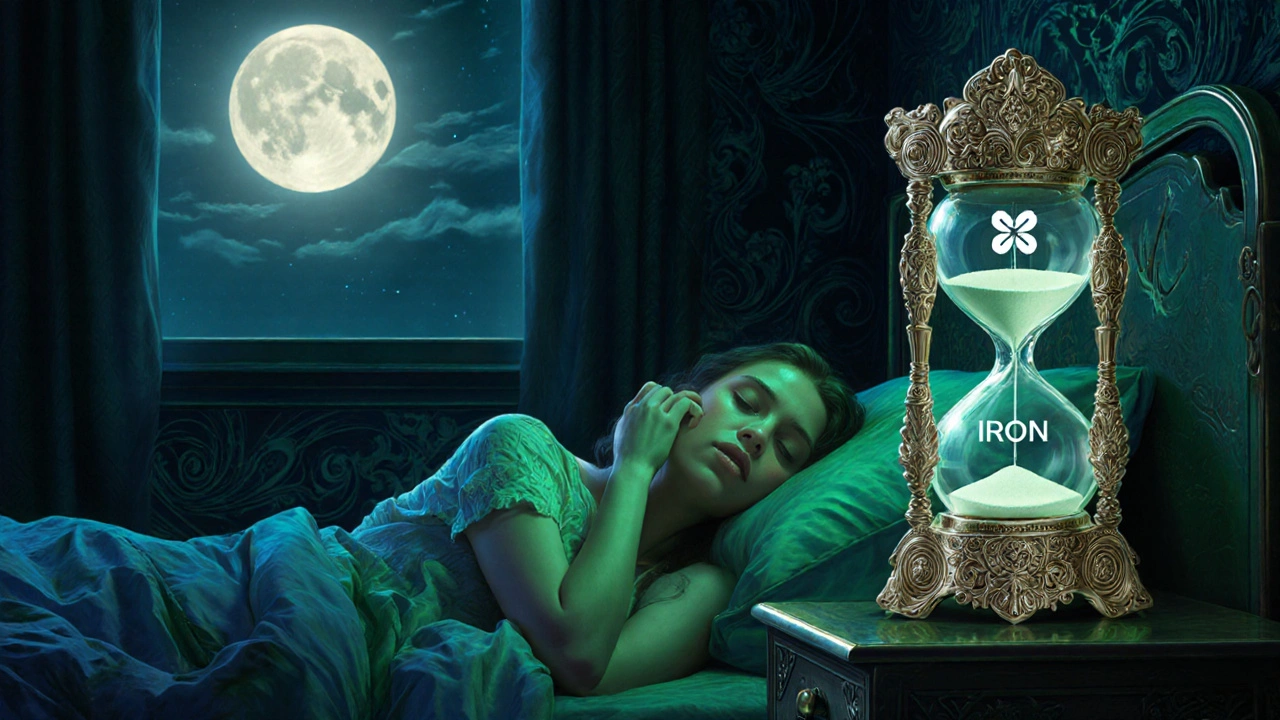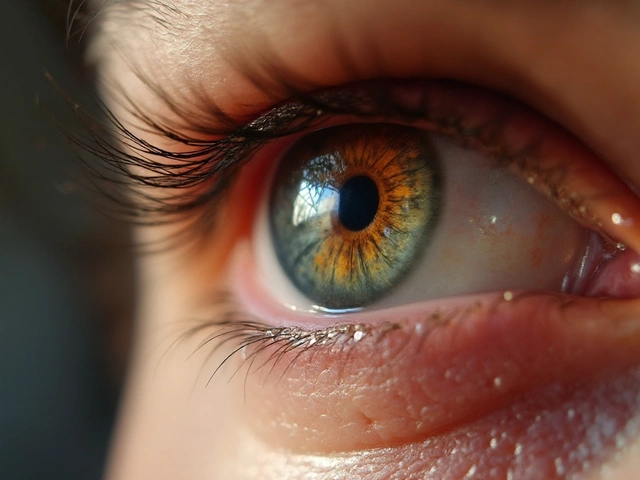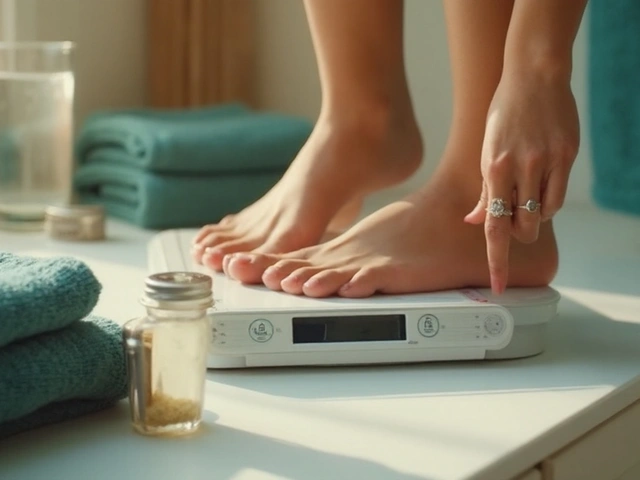If you're taking levothyroxine for hypothyroidism and also need iron supplements for anemia, you're not alone. About 28% of people on thyroid medication also take iron. But here’s the problem: if you take them together, your thyroid medicine might not work at all. Iron binds to levothyroxine in your gut, forming a useless compound your body can't absorb. Studies show this can cut thyroid hormone absorption by up to 39%. The result? Your TSH levels spike, you feel tired, gain weight, and get cold easily-even if you're taking your pills exactly as prescribed.
Why Iron and Levothyroxine Don't Mix
Levothyroxine is absorbed in the upper part of your small intestine. Iron, especially ferrous sulfate (the most common type), sticks to it like glue. This isn't just a theory-it's been proven in clinical studies since 1976. When they meet in your stomach or intestines, they form an insoluble complex. Your body can't break it down. So instead of your thyroid hormone entering your bloodstream, it just passes through and gets flushed out. The interaction isn't the same with all iron types. Ferrous sulfate causes the strongest binding. Ferrous gluconate is slightly less disruptive, but still problematic. Even slow-release or chelated iron forms still interfere. There’s no safe iron supplement to take at the same time as levothyroxine. The only way to avoid this is time.The 4-Hour Rule: What the Experts Say
Major medical organizations agree: separate your doses by at least four hours. The British National Formulary (BNF 2024), NICE guidelines (2023), Synthroid’s official prescribing info, and MedlinePlus all say the same thing: take levothyroxine and iron at least four hours apart. Why four hours? Because levothyroxine is absorbed quickly-usually within 30 to 60 minutes if taken on an empty stomach. Iron takes longer to be absorbed, especially if taken with food. Waiting four hours ensures your thyroid hormone is already in your bloodstream before the iron starts its journey. A 2022 study found that patients who stuck to this rule maintained normal TSH levels 89% of the time. Those who didn’t? Only 62% stayed in range. Some sources, like Thyroid UK, suggest two hours might be enough. But that’s risky. Everyone’s digestion moves at a different speed. If you have celiac disease, IBS, or just a slower gut, two hours won’t cut it. Four hours is the safety buffer doctors recommend for a reason.When to Take Each Pill: Real-Life Timing Strategies
Most people take levothyroxine first thing in the morning, 30 to 60 minutes before breakfast. That’s fine-but then you’d need to wait until mid-afternoon to take iron. For many, that’s not practical. Here’s what actually works for patients:- Option 1: Morning thyroid, lunchtime iron - Take levothyroxine at 7 a.m. with water, wait until 12 p.m. or 1 p.m. to take iron with food. This is the most common successful routine.
- Option 2: Bedtime thyroid, morning iron - Take levothyroxine at 10 p.m., at least four hours after dinner. Then take iron at 7 a.m. the next day. Many patients find this easier because they don’t have to remember two separate daytime windows.
- Option 3: Iron at night, thyroid in the morning - If iron makes you nauseous on an empty stomach, take it at bedtime. Wait at least four hours after your last meal, then take levothyroxine at 6 a.m. This works if you’re not eating late.

What If Iron Makes You Nauseous?
Iron supplements often cause stomach upset. That’s why many people take them with food. But levothyroxine must be taken on an empty stomach. This creates a classic catch-22. Here’s how to solve it:- Take iron with vitamin C. Vitamin C boosts iron absorption so you can use a lower dose. A 325 mg iron tablet with 200 mg of vitamin C works as well as a 650 mg tablet without it. Less iron = less nausea.
- Try a gentler iron form. Ferrous gluconate or iron bisglycinate cause fewer stomach issues than ferrous sulfate. They still interact with levothyroxine-but at least you’ll feel better while taking them.
- Don’t take iron with coffee, milk, or calcium. These also block absorption. Stick to water.
What Happens If You Mix Them?
Taking iron and levothyroxine together doesn’t cause poison. It just makes your thyroid medicine ineffective. Your body thinks it’s getting enough hormone-but it’s not. Over weeks or months, your TSH rises. You start feeling like you did before treatment: exhausted, depressed, cold, gaining weight. A 2024 audit at a UK NHS trust found that 84% of patients taking both meds were doing it at the same time. Their TSH levels were consistently high. After being educated on the 4-hour rule, 78% saw their levels return to normal within two months. If you’ve been taking them together, don’t panic. Just start separating them now. Check your TSH in six to eight weeks. You might need a small dose adjustment, but your body will respond.How to Remember the Timing
People forget. Especially older adults managing five or six pills a day. A 2023 survey found 41% of patients over 65 found the timing too hard to stick to. Use these tricks:- Set phone alarms. One for levothyroxine, one for iron. Label them clearly: “Thyroid - empty stomach” and “Iron - after food.”
- Use a pill organizer. Fill two separate compartments: one for morning thyroid, one for lunch iron. Color-code them.
- Download a thyroid app. The American Thyroid Association’s app has a built-in medication timer. Over 45,000 people use it.
- Print a chart. Thyroid UK offers a free “Medication Timing Chart” that shows exactly when to take each pill. Download it. Tape it to your fridge.

What Your Doctor Should Be Doing
You shouldn’t have to figure this out alone. Yet a 2024 JAMA study found that only 37% of primary care doctors routinely counsel patients on this interaction. That’s a gap in care. Ask your doctor:- “Can you confirm I’m taking iron and levothyroxine at least four hours apart?”
- “Should I get a TSH test in six weeks after starting iron?”
- “Is there a gentler iron option I can try?”
The Future: New Iron That Doesn’t Interfere
PharmacoLever is testing a new chelated iron called “ThyroSafe Iron” in Phase II trials. Early results show it binds to levothyroxine 87% less than standard iron. If approved, it could change everything. But that’s still years away. For now, the 4-hour rule is your best-and only-tool.Bottom Line: Timing Saves Your Treatment
You’re taking levothyroxine because your thyroid isn’t working. You’re taking iron because your body needs it. Both are essential. But if you take them together, you’re wasting one of them. The fix is simple: separate them by four hours. Choose a routine that fits your life-morning thyroid with lunch iron, or bedtime thyroid with morning iron. Stick to it. Use alarms. Talk to your doctor. Get your TSH checked after six weeks. This isn’t about being perfect. It’s about being consistent. And consistency is what keeps your thyroid levels stable, your energy up, and your life on track.Can I take iron and levothyroxine at the same time if I space them by two hours?
No. While some sources suggest two hours might work for healthy people, studies show absorption drops by up to 39% even with a two-hour gap. The 4-hour separation is the standard because it accounts for differences in digestion speed, gut health, and medication timing. Don’t risk it-stick to four hours.
What happens if I accidentally take them together?
One mistake won’t ruin your treatment. But if it happens often, your thyroid hormone levels will drop over time. You may start feeling fatigued, gain weight, or feel colder than usual. Check your TSH in 6-8 weeks. If it’s high, your doctor may need to increase your levothyroxine dose temporarily until your timing is consistent.
Can I take iron at bedtime instead of in the morning?
Yes, and many patients find this easier. Take levothyroxine in the morning on an empty stomach, then take iron at bedtime-four hours after your last meal. This avoids the conflict with breakfast and often reduces nausea since you’re lying down. Just make sure you’re not eating right before bed.
Does the brand of levothyroxine matter for this interaction?
No. Whether you take Synthroid, Levoxyl, Tirosint, or generic levothyroxine, the chemical interaction with iron is the same. The active ingredient is identical. What matters is timing, not the brand.
Should I stop taking iron if I’m on levothyroxine?
No. Iron deficiency is serious and can cause anemia, heart problems, and extreme fatigue. The solution isn’t to stop iron-it’s to take it at the right time. Work with your doctor to find a schedule that works. Most people manage it successfully with simple timing adjustments.
How long does it take to see improvement after fixing the timing?
Your body starts absorbing levothyroxine properly within days of separating the doses. But it takes 4-6 weeks for your TSH levels to stabilize and reflect the change. That’s why doctors recommend a blood test at the 6-week mark. Don’t judge how you feel-check the numbers.







Erika Lukacs
November 16, 2025 AT 00:25It's wild how something so simple-timing-can make or break your entire treatment. I used to take both at breakfast and wonder why I was still exhausted. Four hours apart? Changed my life. No more brain fog, no more 3 p.m. crashes. It's not magic, it's biology.
Rebekah Kryger
November 16, 2025 AT 13:32Let’s be real-this 4-hour rule is just pharmaceutical theater. The real issue is that levothyroxine is a shitty drug with a 12% bioavailability ceiling. Iron’s not the villain; the synthetic T4 is. If you’re relying on this, you’re already losing. Go natural. Desiccated thyroid. End of story.
Victoria Short
November 16, 2025 AT 21:18i just take my thyroid pill when i wake up and iron before bed. it works. no need to overthink it.
Eric Gregorich
November 18, 2025 AT 07:30Look, I get it. We’re all just trying to survive modern medicine’s chaos. But this isn’t just about iron and levothyroxine-it’s about how our bodies are treated like machines with fixed algorithms. The fact that we need to time pills like rocket launches? That’s not healthcare. That’s pharmaceutical gymnastics. We’ve turned self-care into a logistical nightmare because the system doesn’t care if you’re tired, broke, or confused. You’re just supposed to adapt. And yet, here we are-reading 2000-word guides on when to swallow a pill. That’s the real tragedy. The science is solid, sure. But the culture? Broken.
Koltin Hammer
November 19, 2025 AT 04:05I’ve been on levothyroxine for 11 years and iron for 7. I used to take them together-felt like a zombie. Then I tried bedtime thyroid, morning iron. It’s not perfect, but it’s sustainable. What’s interesting is how this mirrors broader patterns: we’re told to optimize everything, but no one gives us the tools. Alarms? Pill organizers? Apps? These aren’t luxuries-they’re survival tools for people managing chronic illness. And yet, doctors still act like it’s common sense. It’s not. If you’re over 50, juggling five meds, and working two jobs, you don’t have time to be a pharmacologist. We need better systems, not just better timing.
Ashley B
November 20, 2025 AT 04:274-hour rule? LOL. That’s what they want you to believe. The real reason they push this is because Big Pharma doesn’t want you taking natural iron supplements that don’t interfere. They make billions off your confusion. Ferrous sulfate? Patentable. Chelated iron? Not so much. And don’t get me started on how Synthroid is just a rebranded generic with a $500 price tag. Wake up. This isn’t science-it’s profit.
Sharon Campbell
November 21, 2025 AT 06:53why do u even need iron if u r on thyroid med? maybe ur diet is trash. also i take mine together and im fine. maybe ur body just sucks.
sara styles
November 22, 2025 AT 09:37You think this is about timing? It’s about glyphosate. It’s about fluoridated water. It’s about the fact that your gut flora is dead from antibiotics and processed food. Iron doesn’t bind to levothyroxine-you’re just too toxic to absorb anything. Take probiotics. Do a liver cleanse. Stop eating gluten. Then maybe you won’t need to time your pills like a NASA launch. The 4-hour rule is a bandaid on a bullet wound.
Brendan Peterson
November 23, 2025 AT 14:21For what it’s worth, I’ve been taking Synthroid at 6 a.m. and iron at 1 p.m. for 18 months. TSH stable at 1.9. No issues. But I also take vitamin C with iron and avoid dairy. That’s the real key-context. The 4-hour rule is a baseline. What matters more is consistency, diet, and avoiding calcium and coffee. Also, if your doctor didn’t explain this to you, find a new one.